| Stitching involves taking cut material, placing it on the sewing mount, then running it through a sewing machine. This operation may require pinch grips and awkward arm, neck, and trunk postures. Force may also be required to push fabric through the machine. Some of the common risks and possible solutions associated with stitching are listed below.
|
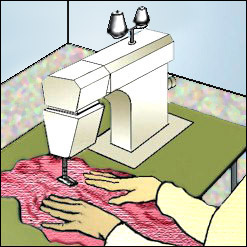 |
| Moving
Material to/from Workstation |
 |
|
Potential Hazards:
- Workers reach overhead (Figs. 1 & 2), to the side (Fig. 3), behind, or down into tubs to pick up or place fabric. This action can cause stress on the arms, neck, shoulders, and back.
|
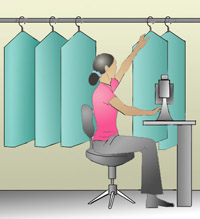
Fig. 1
Reaching overhead to pick up fabric can cause stress on the arms, neck, and shoulders.
|
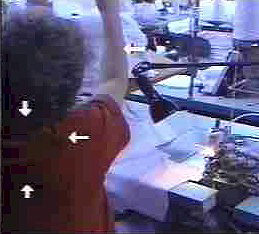
Fig. 2
Reaching overhead to place fabric. |
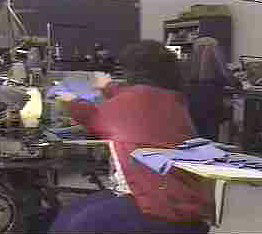
Fig. 3
Reaching to the side to place fabric.
|
- Workers bend/twist to pick up fabric (Fig. 4), which can hurt a worker's back and shoulders.
|

Fig. 4
Twisting to pick up fabric. |
Possible Solutions:
- Minimize overhead reach by:
- Lowering the rack (Fig. 5); or
- Placing station on platform or using height-adjustable portable clothing racks or tables.
|
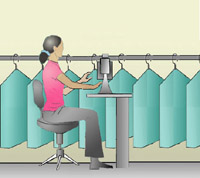
Fig. 5
Lowering the clothing rack can minimize overhead reach.
|
- Minimize reaches to the side or behind associated with picking up new product or placing completed fabric by:
- placing fabric/bins closer to the worker (Fig. 6);
- placing fabric/bins at table height;
- using height-adjustable fabric containers;
- adding an extension to work table; or
- using an automated or conveyor system that transports the fabric directly to and from the worker.
|
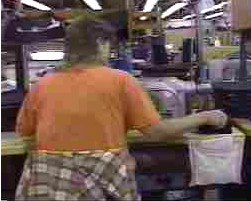
Fig. 6
Minimize reach by placing material closer to the worker.
|
- Use swivel chairs (Fig. 7), which allow workers to turn to get bundles and pieces, rather than twisting to reach to the side or behind. Swiveling can also make it easier for workers to sit down and get up from the workstation.
|
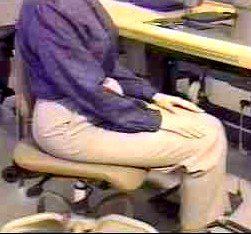
Fig. 7
Swivel chairs allow workers to maintain good back posture. |
|
| Setting Up Material |
 |
|
Potential Hazard:
- When setting up material for stitching, workers may have to flex or bend their necks to view the position of the fabric.
|
Possible Solutions:
- Use automatic feeding and set up, which eliminates the operator using awkward postures.
- Provide proper lighting:
- Use adjustable task lighting to make it easier for the worker to see product during set up (Fig. 1).
- Ensure bulbs are replaced frequently so they are functional at all times.
- Provide properly positioned general overhead lighting.
|
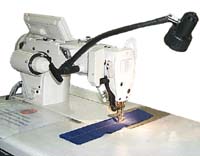
Fig. 1
Adjustable task lighting. |
|
| Manipulating Material |
 |
|
Potential Hazard:
- While manipulating fabric, employees repeatedly use a forceful pinch grip (Fig. 1) between the thumb and index finger.
|
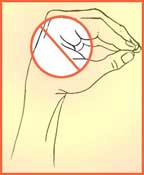
Fig. 1
Pinch grip. |
Possible Solutions:
- Use friction-increasing aids (Fig. 2) on fingers to reduce amount of force exerted in the pinch grip.
- Analyze tasks to determine force requirement and use job/task rotation through tasks not requiring pinch grip.
|
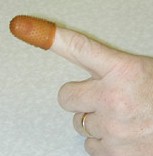
Fig. 2
Friction-increasing aid. |
|
| Stitching Material |
 |
|
Potential Hazard:
- Employees push fabric through the sewing machine, which may require extending arms, bending at the waist, and applying force (Fig. 1).
|
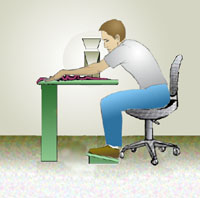
Fig. 1
Awkward posture causing ergonomic stress to arms, shoulders, and back. |
Possible Solutions:
- Use height adjustable tables (Fig. 2), which, when properly adjusted,
may reduce arm extension and bending at the waist.
- Allow the machine to pull the fabric through rather than having the operator push the fabric.
- Reduce the distance between the operator and the machine.
|
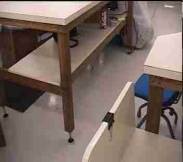
Fig. 2
Height-adjustable table. |
|
|
